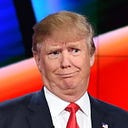Day 1,099: Trump invites farmers and industrial facilities to pollute rivers and wetlands
Donald Trump has previously said, “ I believe very strongly in very, very crystal clear, clean water and clean air.”
It turns out, he very, very much doesn’t.
The Trump administration is severely rolling back Obama-era clean water policies, opening the door for a vast amount of pollutants to enter more rivers, streams and wetlands. The change adversely affects “protect[ions to] rivers, streams, wetlands and other bodies of water from pollution and runoff from industrial facilities and agriculture…”
Under the EPA’s new rules, the federal government will no longer protect streams that only flow during some parts of the year or after heavy rain, or wetlands that are not connected to larger bodies of water.
While Trump claimed the old rule hindered agricultural and industrial groups and failed to impact the environment as a whole, the government’s own scientists worry about the wide-reaching effects of the new rules.
A group of scientific advisors to the EPA analyzed the rule as being “in conflict with established science” and said the change would actually “decreases protections for our nation’s waters.”
Administration officials said they did consider science on the relationship between bodies of water in drafting the rule, but said they are also constrained by limited legal authority.
Critics of the change cited their analysis, saying the Trump administration is ignoring the impact of seasonal streams that still have a tangible impact downstream in the event of heavy rain or flooding that may wash dirt, debris or pollution into rivers or lakes that provide drinking water or support wildlife.
One of the biggest concerns is that fertilizer and pollution from agriculture could be released into areas that will no longer be protected under the new rule. Heavy rain events could also send any pollution downstream into larger bodies of water, affecting sources of drinking water or adding to toxic algae blooms.
And while the EPA acknowledged that the change makes nearly all streams wetlands unprotected in certain areas, they ended up shrugging their shoulders anyway.
The EPA’s own analysis found that in some regions the change will mean the vast majority of streams and wetlands are no longer federally protected. In the Rio Grande Valley, for example, the EPA says 85% to 91% of stream miles are ephemeral and would no longer be protected — and 34% to 62% of all wetland acres are non-abutting wetlands and would no longer be covered by the rule.
But the agency says there is not enough data to evaluate what percent of streams or wetlands around the country would be impacted by the change.
The federal government has effectively kicked environmental protections to states. The problem, of course, is that pollution in one state can easily end up affecting one, two or seven more. So lax rules in one state can still cause tremendous harm to a state with stricter rules.
The federal government is uniquely equipped to deal with the issue and preventing more contaminants from entering water sources. Instead, Trump wants to talk about protecting water while at the same time allowing it to be polluted.
1,099 days in, 363 to go
Follow us on Twitter at @TrumpTimer
